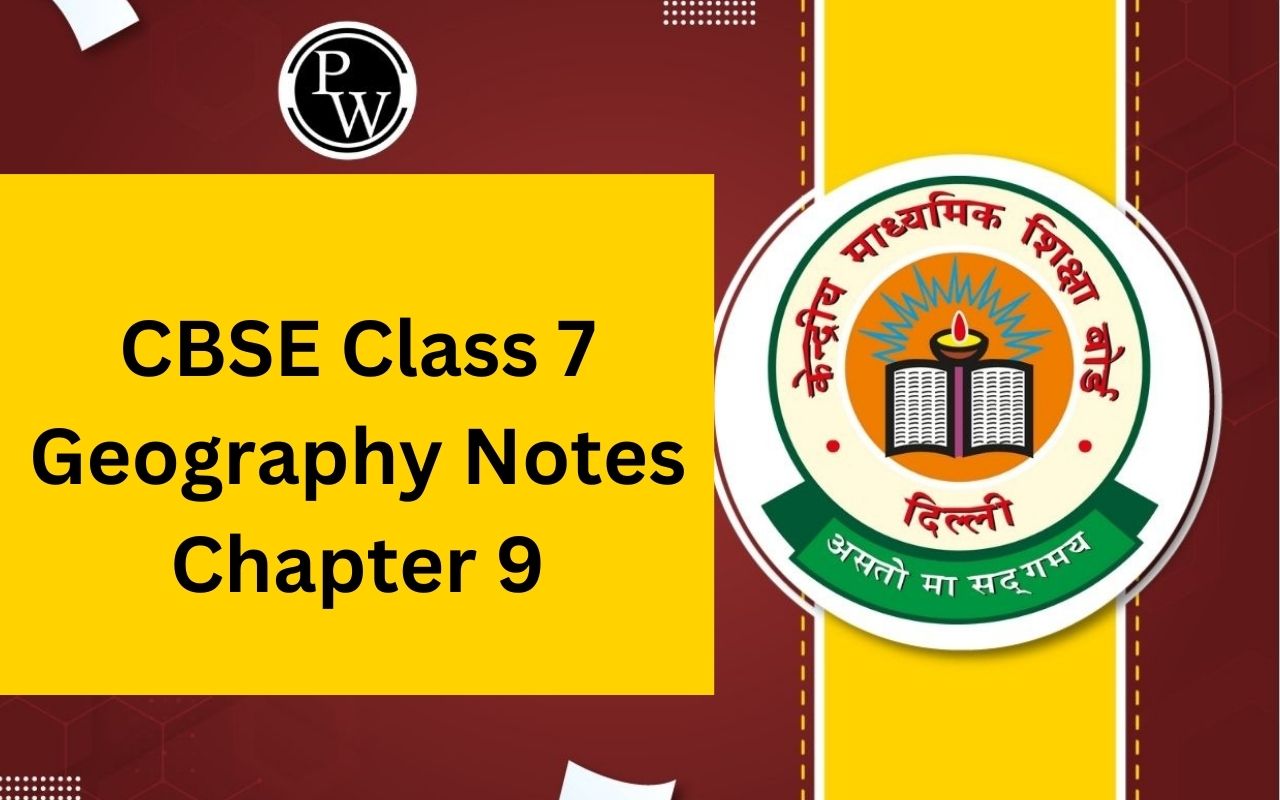

CBSE Class 7 Geography Notes Chapter 9: A desert is a desolate region of the environment with minimal precipitation and unfavorable living conditions for both plant and animal life. It is categorized as either a cold desert or a hot desert.
People, plants, and animals find it challenging to survive in desert regions due to the extreme temperatures and infrequent rainfall. By reading these CBSE Class 7 Geography notes for Chapter 9, which are available on our website, students can gain a complete understanding of the chapter Life in the Deserts.CBSE Class 7 Geography Notes Chapter 9 Overview
Earth is a planet with several distinct physical characteristics. There are plains someplace, and there are elevation places like plateaus. Mountains, grasslands, islands, coastal regions, and deserts are some examples of additional physical features. We shall examine the deserts in this article. We shall study the characteristics of two distinct types of deserts. The NCERT and CBSE Class 7 Geography chapter on "Life in the Deserts" will be covered in this article. You can better grasp this chapter with the aid of these notes.CBSE Class 7 Geography Notes Chapter 9 PDF
Therefore, we have included the Class 7 Geography Notes on "Life in the Desert" below. Experts in subject area have developed these notes based on the most recent NCERT and CBSE syllabus and themes. We have discussed deserts, one of the significant geographical elements, in this. According to the syllabus, we have studied about the two main types of deserts in the globe, as well as their characteristics and associated ideas. We think that the notes for Class 7 Geography Chapter 9 will be helpful to you in comprehending and effectively rewriting this chapter. On our website, you can get notes on other pertinent subjects or chapters of any subject.CBSE Class 7 Geography Notes Chapter 9 PDF
CBSE Class 7 Geography Notes Chapter 9
Here we have provided CBSE Class 7 Geography Notes Chapter 9 for the ease of the students – A desert is an arid area with little flora and unusually high or low temperatures. There are hot deserts and cold deserts, depending on the weather.The Hot Desert Sahara
The largest desert in the world is the Sahara. It covers about 8.54 million square km. Algeria, Chad, Egypt, Libya, Mali, Mauritania, Morocco, Niger, Sudan, Tunisia, and Western Sahara are the eleven nations that are surrounded by the Sahara Desert. There are raised plateaus with bare rocky surfaces and gravel plains in the Sahara Desert. In certain instances, these rocky surfaces might be higher than 2500 metres.Climate
The environment of the Sahara Desert is harsh, sweltering, and dry. There is a brief wet season there. There are no clouds and a clear sky. In this place, moisture evaporation exceeds condensation rate. The sand and the exposed rocks heat up during the day when temperatures can reach as high as 50°C. This heat then radiates outward, heating the surrounding area. The nights might be extremely cold, with lows close to zero.Flora and Fauna
The vegetation found in the Sahara Desert consists of acacia, date palms, and cacti. There is oasis in some places; they are verdant islands encircled by date palms. There are numerous types of snakes, lizards, foxes, hyenas, jackals, scorpions, and camels among the notable animal inhabitants. High levels of aridity have left the vegetation sparse. There aren't many places for animals to feed on grasses and plants. In the valleys are groves of poplars and willows. Fruit trees that bear apples, apricots, and walnuts bloom in the summer. In Ladakh, one can see robins, redstarts, Tibetan snowcocks, ravens, and hoopoes. A few of these are birds that migrate. Ladakh is home to yaks, wild sheep, goats, and unique breeds of dogs. The purpose of raising the animals is to supply milk, meat, and hides.People
There are numerous groups of people who live in the Sahara desert and engage in diverse activities. Among them are the nomadic Bedouin and Tuareg tribes, who raise horses, camels, goats and sheep. They receive milk from these animals, hides from which they may produce leather belts, slippers, and water bottles, and hair, which is used to make mats, carpets, blankets, and clothing. They shield themselves from hot winds and dust storms by dressing in bulky robes. A permanent population is supported by the Nile Valley in Egypt and the oasis in the Sahara. Date palms are grown by the villagers since water is abundant. Additionally, crops like beans, wheat, barley, and rice are cultivated. Egypt is the home of the world-famous Egyptian cotton crop. The Sahara Desert is continuously changing due to the finding of oil. Iron, phosphorus, manganese, and uranium are among the other minerals that can be found nearby. Changes are occurring in the Sahara's cultural landscape. Superhighways straddle the old camel trails, and gleaming glass-cased business towers rise over mosques. In the salt trade, trucks are taking the place of camels. Foreign tourists are observed being guided by Tuaregs. Nomadic herders are migrating to cities in greater numbers in order to work in the oil and gas industry.The Cold Desert Ladakh
Located on the eastern side of Jammu and Kashmir, in the Great Himalayas, is a frigid desert called Ladakh. It is bounded to the north by the Karakoram Range and to the south by the Zanskar Mountains. The Indus is the most significant of the several rivers that run through Ladakh. Ladakh is home to several glaciers, including the Gangri glacier. In Ladakh, elevations range from roughly 3000 metres in Kargil to over 8,000 metres in the Karakoram. Its high altitude keeps the climate incredibly dry and frigid. The sun's heat is really noticeable at this height due to the extremely thin air. Summertime highs are just above freezing during the day and much below freezing at night. Ladakh receives as little as 10 cm of precipitation annually due to its location under the Himalayas' rain shadow. There are chilling winds and scorching sun in this place.Benefits of CBSE Class 7 Geography Notes Chapter 9
Examine our Revision Notes for Class 7 Social Chapter 9: Life in the Desert's benefits. These notes, which are designed to make studying simple, provide effective exam preparation and a self-assured grasp of life in dry environments by providing concise summaries, simplifying difficult ideas, and offering real-world examples. 1. Rapid Summaries: With succinct and understandable summaries, you can quickly learn the essential ideas of life in the desert. 2. Simplified Learning: A deeper comprehension of the desert ecosystem is facilitated by the clarification of complex themes relating to the desert. 3. Last-Minute Prep: This useful tool concentrates on key elements of desert living and is an efficient means of preparing for exams quickly and effectively. 4. Enhanced Retention: Highlights the particular difficulties and adaptations in desert environments while consolidating important knowledge for better memory. 5. Exam Support: This section covers numerous facets of living in the desert and offers strategic insights, essential ideas, and tips to help with good exam preparation. 6. Time-Saving: Streamlines knowledge, saving important study time, particularly when studying the wildlife, plants, and survival techniques of the desert. 7. Prioritised Topics: Concentrates on significant issues and themes, such as climate change's effects and adaptations for deserts, to guarantee a focused research strategy. 8. Real-world Connections: Using real-world examples, students in Class 7 get a deeper knowledge of life in the desert, including the difficulties faced by communities there and the distinctive ecosystems that they encounter.CBSE Class 7 Geography Notes Chapter 9 FAQs
What is desert class 7 short answer?
A desert is a landscape or region with little or no rainfall and extreme temperatures making the conditions unsuitable for plant and animal life. Features of a desert: Rainfall is very low and irregular. Temperatures are extremely high or extremely low.
What is a short note on the Sahara desert?
The Sahara Desert is the largest hot desert in the world. The Sahara Desert covers 10 different countries — they are Algeria, Chad, Egypt, Libya, Mali, Mauritania, Niger, Western Sahara, Sudan, and Tunisia. The Sahara Desert has dry valleys, mountains, salt flats, barren and rocky plateaus, and sand dunes.
What are the climatic conditions of the Ladakh desert class 7 notes?
The air at this altitude is so thin that the heat of the sun can be felt intensely. The day temperatures in summer are just above zero degrees and the night temperatures are below -30C. Winters are extremely cold with temperatures below -40C most of the time. There is very little rainfall in this region.
🔥 Trending Blogs
Talk to a counsellorHave doubts? Our support team will be happy to assist you!

Check out these Related Articles
Free Learning Resources
PW Books
Notes (Class 10-12)
PW Study Materials
Notes (Class 6-9)
Ncert Solutions
Govt Exams
Class 6th to 12th Online Courses
Govt Job Exams Courses
UPSC Coaching
Defence Exam Coaching
Gate Exam Coaching
Other Exams
Know about Physics Wallah
Physics Wallah is an Indian edtech platform that provides accessible & comprehensive learning experiences to students from Class 6th to postgraduate level. We also provide extensive NCERT solutions, sample paper, NEET, JEE Mains, BITSAT previous year papers & more such resources to students. Physics Wallah also caters to over 3.5 million registered students and over 78 lakh+ Youtube subscribers with 4.8 rating on its app.
We Stand Out because
We provide students with intensive courses with India’s qualified & experienced faculties & mentors. PW strives to make the learning experience comprehensive and accessible for students of all sections of society. We believe in empowering every single student who couldn't dream of a good career in engineering and medical field earlier.
Our Key Focus Areas
Physics Wallah's main focus is to make the learning experience as economical as possible for all students. With our affordable courses like Lakshya, Udaan and Arjuna and many others, we have been able to provide a platform for lakhs of aspirants. From providing Chemistry, Maths, Physics formula to giving e-books of eminent authors like RD Sharma, RS Aggarwal and Lakhmir Singh, PW focuses on every single student's need for preparation.
What Makes Us Different
Physics Wallah strives to develop a comprehensive pedagogical structure for students, where they get a state-of-the-art learning experience with study material and resources. Apart from catering students preparing for JEE Mains and NEET, PW also provides study material for each state board like Uttar Pradesh, Bihar, and others
Copyright © 2025 Physicswallah Limited All rights reserved.











